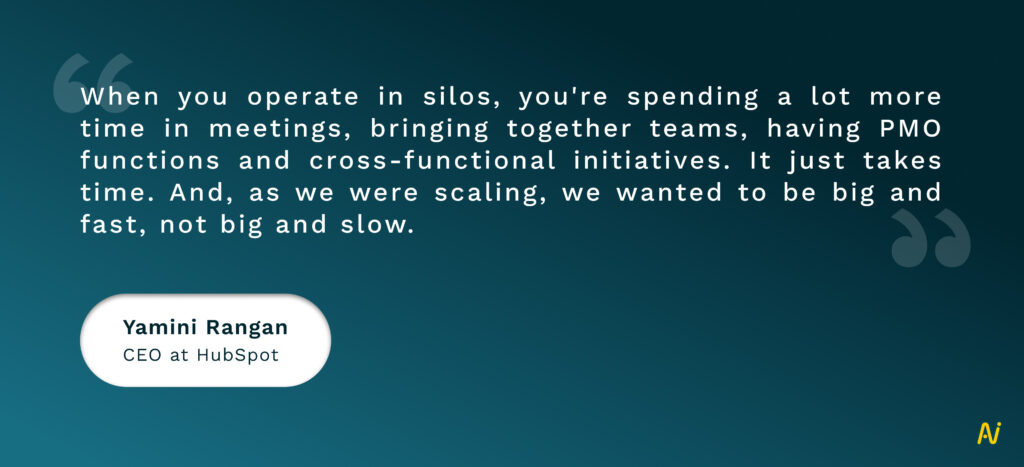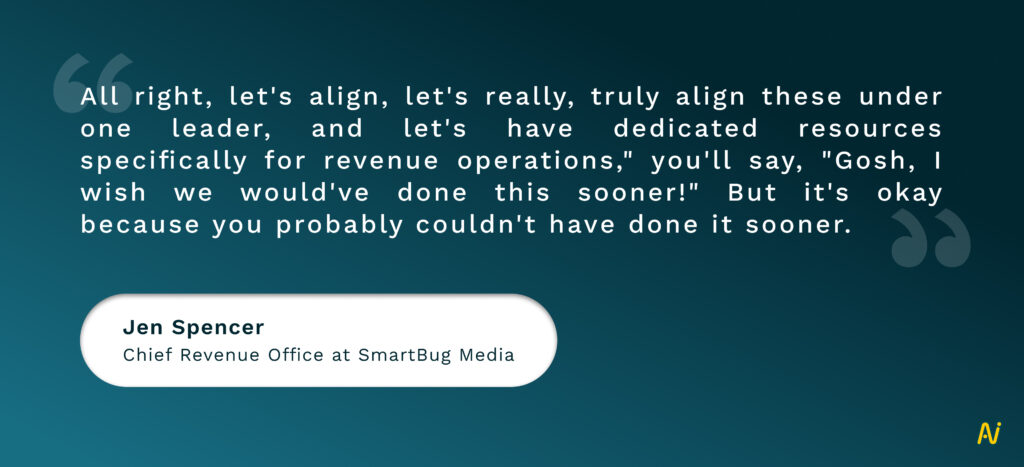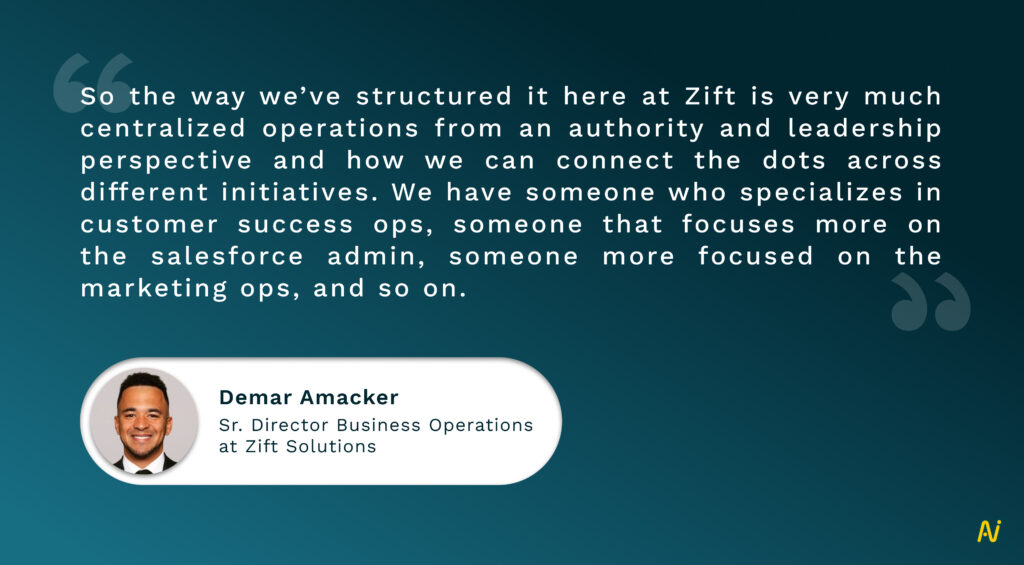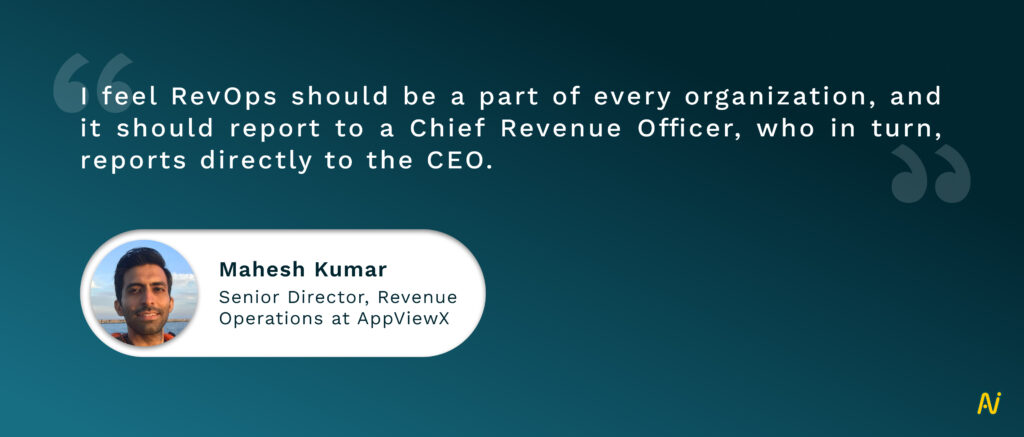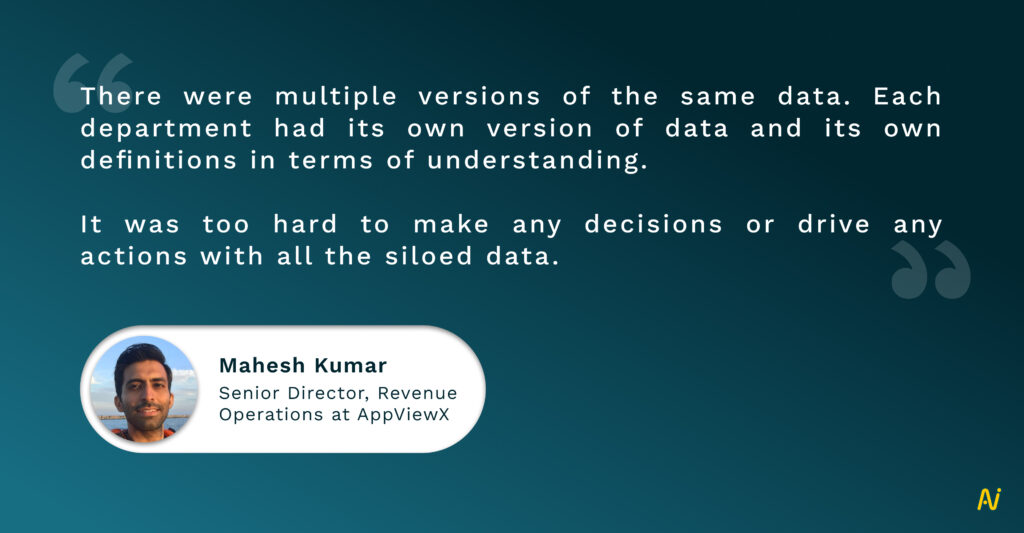
Ideal Revenue Operations Team Structure – What is it and How Does it Look?
This blog explores what an ideal revenue operations team structure should look like. Read on to look at what experts suggest.
Creating an ideal revenue operations team structure can be confusing.
How do you create a team that lives up to all the demands of a RevOps function? A team that ensures that parts of the revenue engine are running smoothly?
Secret sauce to success of RevOps! This crowdsourced ebook has step by step guide on setting up RevOps from scratch.
The truth is – every revenue operations team structure looks different depending on the organization and industry they’re associated with. What a RevOps team looks like, the methods of creating a RevOps team, and their role in the organization are all covered in this blog.
Let’s dive in.
RevOps is Here to Break Siloed Teams & Align Them
In the past, companies that created exceptional products that outperformed the competition were the driving force behind consumer purchasing decisions. However, in the current business landscape, it is organizations that prioritize delivering exceptional customer experience, regardless of the price, that leads the way in driving sales.
It’s evident that having a good customer experience is important, but when it comes down to implementing them, it all depends on the company’s customer-facing team, how organized it is, and how aligned the teams are.
In the process of scaling up, it’s easy to focus on individual teams’ objectives, which can lead to creating silos within teams. Silos within the organization can become frustrating. They lead to cobbled-together tech stacks and internal friction, leading to external friction, eventually leading to a poor customer experience.
Having a team that oversees these silos and works to connect these departments, bringing them in alignment, is why RevOps is needed in the organization, which will be a make-or-break factor.
When is the Best Time to Start Building a RevOps Team?
Creating a revenue operations team structure in the organization is definitely a step towards growth but poses a rather compelling question most leaders often ask, “When do you start putting a RevOps team in place?”
The question of when is the right time to involve a RevOps team is debatable. Different companies in different industries have their own time to bring on a RevOps mode of thinking. Truth be told, there is no right time for this. The safe approach to this would be to start as early as possible.
Start as early as you possibly can, say revenue experts.
“Start as early as you possibly can. Even if you are a one person team, you can understand what those priorities are and you can begin to earmark the things you want to accomplish in the coming quarters. Coming in at a later stage such as Series B or Series C can get complicated as there is so much historical data with no consistency around it. And it really makes for a complicated clean-up effort. RevOps is not just the accountability partner. They are the educator, the glue, the foundation, the art and the science behind the intent of really hyper growth.”
Briana Yarborough, VP Revenue Operations at Pontoon Solutions
As RevOps emerges as a growing function, most leaders are of the opinion that no matter what stage your company is at, starting a RevOps function should be your top priority. Getting it too late can mean the RevOps person cleaning up the mess created by historical data and tech debt. With a RevOps team from the very beginning, a lot of these messes can be prevented.
Related Resource: What is RevOps?
I often see companies in much later stages realize they’ve given no love and attention to RevOps. It often takes almost a year to get this on stable footing. Plus, as your historic data is also often a mess or missing visibility you start from ground zero once these frameworks and processes are in place. Start early! I can’t stress this enough. The other thing is we’re often putting in a junior person to start this function and they have no IRL and business being a strategic RevOps player. It’ll benefit your company in the long run to have a fractional team with deep expertise to get this right from the onset. Think of us as your RevOps fairy godparents.
Stacie Sussman, Revenue Growth Architect at RevOps Advisory
Demar further emphasizes that it’s important to instill the culture of RevOps within the team with rigor early on. Sales teams can start looking at processes more operationally in their system, while marketing folks should start inculcating it in campaign structures and imbibe the data-focused mentality early on; otherwise, it will all accumulate to undigestible tech and product debt, leading to bad handovers among departments, affecting the overall customer experience.
What does a Revenue Operations Team Structure Look Like?
Creating a revenue operations team structure necessitates careful consideration of the overarching company objectives. The size and nature of the organization, as well as the industry-specific nuances, all play a crucial role in determining the structure of the RevOps team. Hence, each RevOps team might look different for different companies depending on the industry.
One method that can be considered for creating a RevOps team involves adopting the committee method. A member from each team – marketing head, sales head, etc. – can be picked to report to the revenue manager, granting unmitigated visibility.

Alternatively, some organizations choose to have an entire RevOps team reporting to the CRO or COO. This is apt for organizations that are scaling their operations over time. Such teams would take charge of deciphering revenue gaps and maintaining interdepartmental communications with necessary stakeholders.
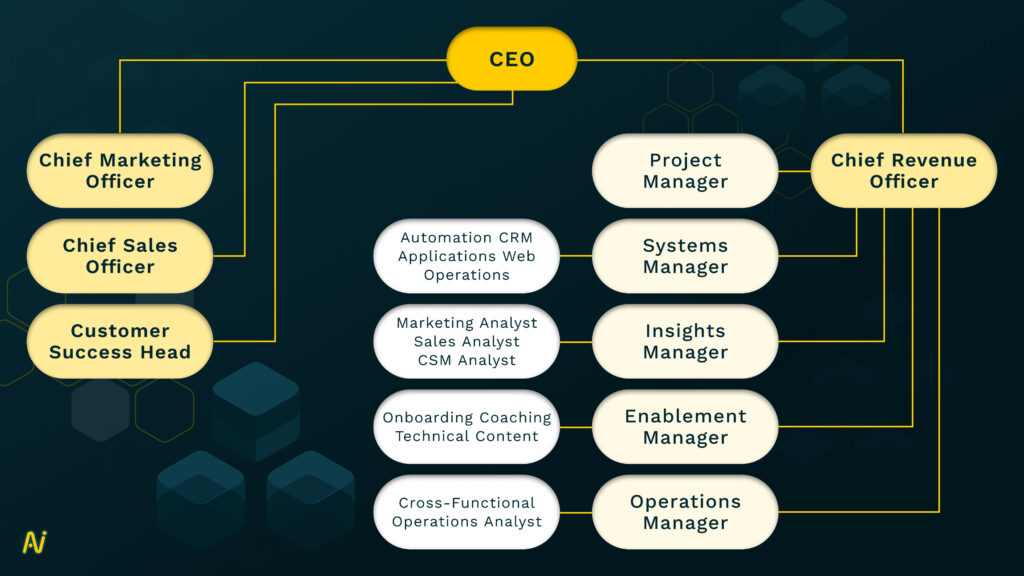
Excerpts from our podcast between Abhijeet Vijayvergiya and Demar Amacker below is an ideal example of the second type.
Abhijeet: Which school of thought do you come from? And is there a choice, or is it very contextual to the business?
Whether you decide to bring in a new RevOps leader or not, structuring a RevOps team demands a fundamental shift in the mindset of the team and the purpose of the work they do in this function.
As a starting point, here are some RevOps team structure roles that can be defined
1. RevOps Manager
As a critical liaison between different departments, the RevOps manager or leader is the first point of contact within the company. Hence, it becomes crucial for a RevOps leader to possess knowledge and expertise in the organization’s tech stack to effectively perform the role.
2. RevOps project manager
Since RevOps works in collaboration with other teams, there can be instances where ad hoc projects or requests – strategy, reporting, or other areas – prop up in addition to their core responsibilities.
To ensure optimal productivity of the RevOps team, it is essential that a specific team member take up ownership of this to prioritize and filter these requests. This approach prevents undue distractions and ensures that the team’s workflow remains unaffected.
3. RevOps Analytics
Traditional organizations or those that haven’t adopted RevOps are bound to be infested with data silos.
And since performance metrics are paramount in understanding the direction the company is moving, it’s crucial that all data is aligned. This means encompassing a wide range of tasks, including building reports and aggregating data across multiple systems.
To streamline operations and boost efficiency, many RevOps teams opt to create dedicated teams to focus solely on analytics.
In most cases, this kind of role can be handled by those who have a knack for numbers and possess the skills and expertise of where the data is located and how to collect it.
4. Platform Management
Your tech stack is ideally the backbone of your organization. Experienced RevOps leaders will tell you that it’s not the latest additions or tools you add to your tech stack that will be game-changing but rather how well you understand the current tools and churn out the most from them.
Hence, to obtain maximum efficiency of your tech stack, having an expert in platform management is essential.
While larger organizations can afford to employ someone dedicated to this role, smaller firms can assign members for each platform and come together at regular intervals and give updates accordingly.
Track what matters! Download The Ultimate Guide to RevOps Metrics, and drive growth like never before.
Who Should RevOps Report to?
The question of where RevOps function should sit in the organization and to whom it should be accountable has been a subject of ongoing debate. This stems from the fact that RevOps functions vary depending on the organizational structure.
Nonetheless, it is widely accepted that RevOps function, as the sole entity within the organization that possesses a comprehensive view of the revenue funnel – from lead generation to purchase and even post-purchase – is a critical component of any organization. As such, determining the appropriate placement of RevOps and establishing accountability is paramount for organizations seeking to optimize their revenue streams.
A RevOps person will have direct interactions with all departments.

How To Structure a RevOps Team in 3 Easy Steps:
1. Identify the company goals and objectives and resources
For RevOps to function smoothly, it’s important to have a clear understanding of the company’s overall vision and goal and accordingly blend the RevOps function into the system that will give the required boost the organization will need to achieve its objectives.
2. All team members need to speak one language
Each department that contributes direct revenue to the organization has its own metrics and data. As a RevOps function, it becomes paramount to understand each of these metrics and unify them for all departments.
One of Mahesh Kumar’s biggest challenges was getting each department on the same page.
Hence, it becomes crucial to ensure everyone has the same understanding of the data being reported. This calls for sitting with each department and cognizing them of the problems of siloed data and how there is a need to bring all of them together and establish a single source of truth for the company to drive revenue.
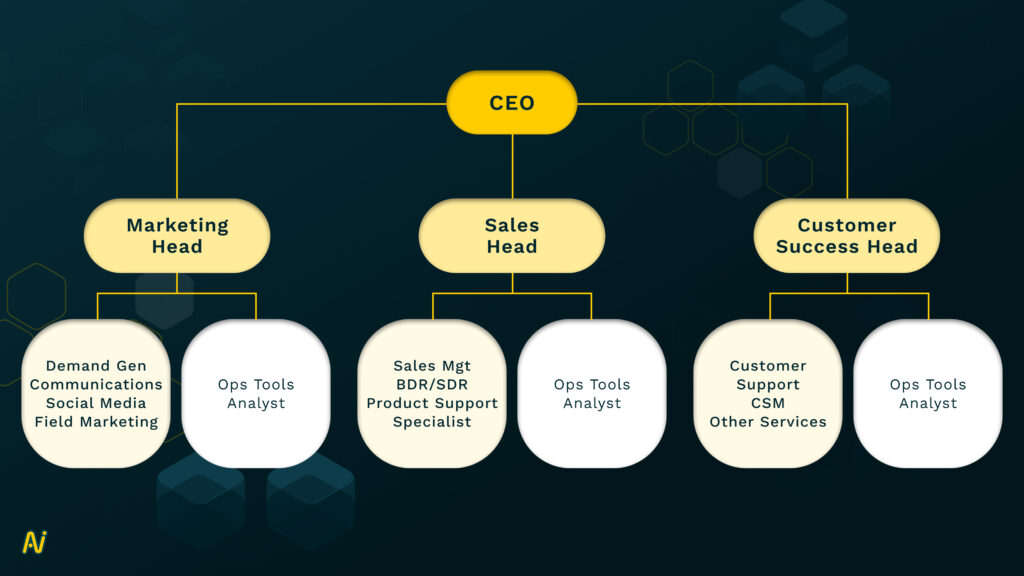
3. Invest in the right tools
There is no dearth of technological tools available in the market today. In fact, the options available can become overwhelming for anybody.
In fact, we have Nektar’s co-founder, Abhijeet Vijayvergiya, and Demar Amacker, Sr. Director of Business Operations at Zift and a renowned leader in the field of RevOps, shed light on setting up a team for RevOps and the approach he’s taken for Zift.
Getting different departments to inculcate the revenue operations mindset into their process early is paramount. Otherwise, businesses will end up accruing significant tech debt, process debt, and bad culture. Thus, it’s advisable to onboard someone who has first-hand experience in RevOps at a mid-level stage to guide the implementation and ensure effective adoption throughout the organization.
Wrapping It Up
There is no hard and fast rule on the perfect revenue operations team structure. Organizations depending on their size and scale can define the structure as long as the common agenda of increasing revenue with shared goals is aligned.
Like every race, where all teams need to be in sync at every stage to win, each team in the organization needs to have clear visibility on the process, speaking the same lingo – maximizing revenue.
Check the gaps in your CRM, with an no-obligation free CRM scan report.
PUBLISHED BY
